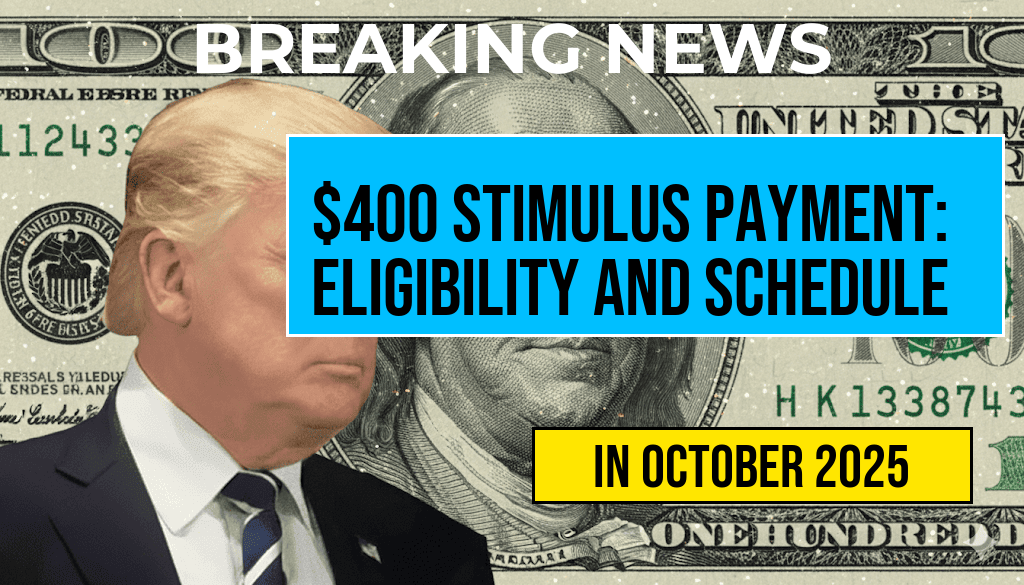The recent announcement of a $400 stimulus payment has garnered significant attention across the United States as many Americans continue to feel the economic effects of inflation and rising living costs. This comprehensive guide outlines the eligibility requirements for the payment, the payment schedule, and other essential details. The initiative aims to provide financial relief to qualifying individuals and families, making it crucial for potential recipients to understand how to access these funds. With the payment structured to ease financial burdens, especially among low- and middle-income households, this guide serves as a vital resource for navigating the upcoming disbursement.
Eligibility Requirements
To qualify for the $400 stimulus payment, individuals must meet certain criteria established by the government. Below are the key eligibility requirements:
- Income Threshold: Individuals must have an annual income of less than $75,000. For heads of households, the limit is set at $112,500, while couples filing jointly can earn up to $150,000.
- Residency: Applicants must be residents of the state offering the payment. Each state may have different regulations, so it is important to verify local requirements.
- Tax Filing Status: Eligible individuals need to have filed a federal tax return for the year 2021 or 2022.
- Age Requirement: Payments are available to those aged 18 and older, including dependents who meet the other criteria.
Payment Schedule
The rollout of the $400 stimulus payments is expected to occur in several phases, depending on the state and the payment method chosen by recipients. Here’s a general timeline:
| Phase | Expected Date | Payment Method |
|---|---|---|
| Initial Disbursement | March 15, 2024 | Direct Deposit |
| Subsequent Payments | April 15, 2024 | Checks and E-Payments |
| Final Disbursement | May 15, 2024 | All remaining payment methods |
Application Process
Eligible individuals must follow specific steps to receive the $400 stimulus payment. The application process generally includes:
- Online Application: Most states will provide an online portal where applicants can submit their information. It is essential to complete this step accurately to avoid delays.
- Documentation: Recipients will need to provide proof of income, residency, and tax filing status. This may include tax returns, identification, and utility bills.
- Verification: After submitting the application, there may be a verification period where state officials review the information. Applicants should monitor their email or online account for updates.
Additional Information
For those who may not qualify for the $400 stimulus payment, there are other forms of assistance available. Various federal and state programs aim to help individuals and families cope with financial difficulties. Resources such as Benefits.gov can provide information on available aid.
As the payment date approaches, recipients are encouraged to stay informed about any changes or updates regarding the stimulus payment. State governments will likely issue press releases and updates on their official websites, ensuring that residents have access to the most current information.
For further details, you can refer to the following resources: Forbes on Stimulus Eligibility and Wikipedia on Stimulus Payments.
Frequently Asked Questions
What are the eligibility requirements for the $400 stimulus payment?
To qualify for the $400 stimulus payment, individuals must meet specific criteria, including income thresholds, residency status, and other factors set by the government. Generally, those with a lower income or facing financial hardship are prioritized.
When can I expect to receive my $400 stimulus payment?
The payment schedule for the $400 stimulus payment varies based on when you file your taxes and your eligibility status. Most payments are expected to be distributed within a few weeks of approval, but exact dates may differ.
How will the $400 stimulus payment be disbursed?
The stimulus payment will typically be disbursed through direct deposit for those who have provided their bank details to the IRS. Others may receive checks or debit cards by mail, depending on their filing preferences.
Can I check the status of my $400 stimulus payment?
Yes, individuals can check the status of their $400 stimulus payment through the IRS website or by contacting their customer service. It is important to have relevant information like Social Security numbers and filing status handy.
What should I do if I don’t receive my $400 stimulus payment?
If you do not receive your $400 stimulus payment within the anticipated timeframe, you should first verify your eligibility and payment status. If everything checks out, consider reaching out to the IRS or your local tax office for further assistance.

Leave a Reply